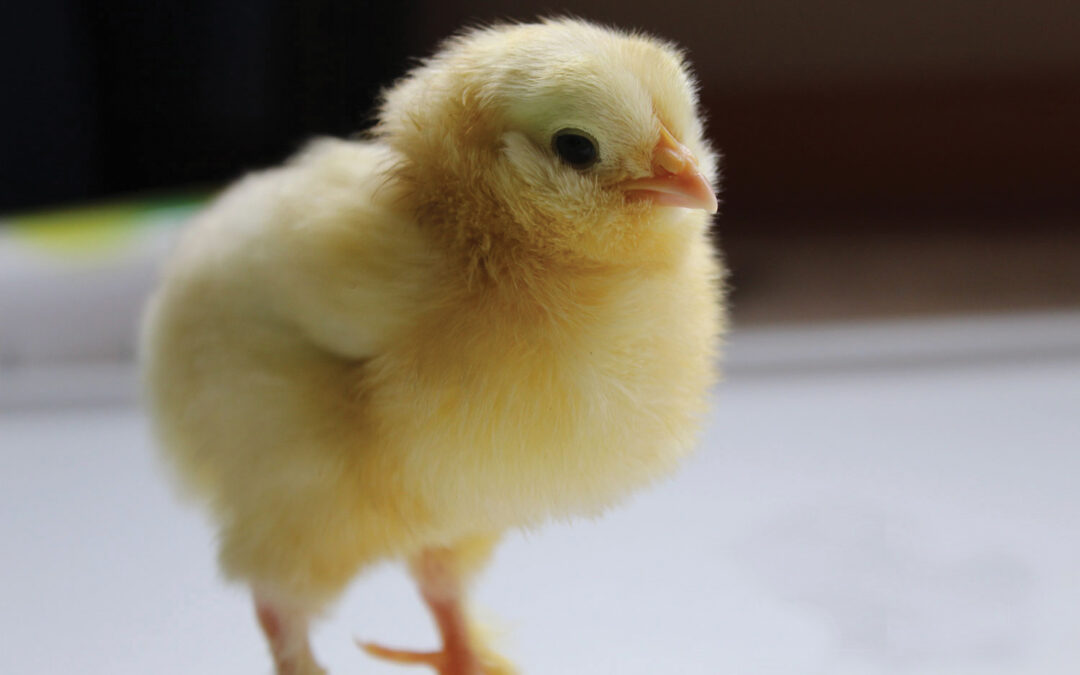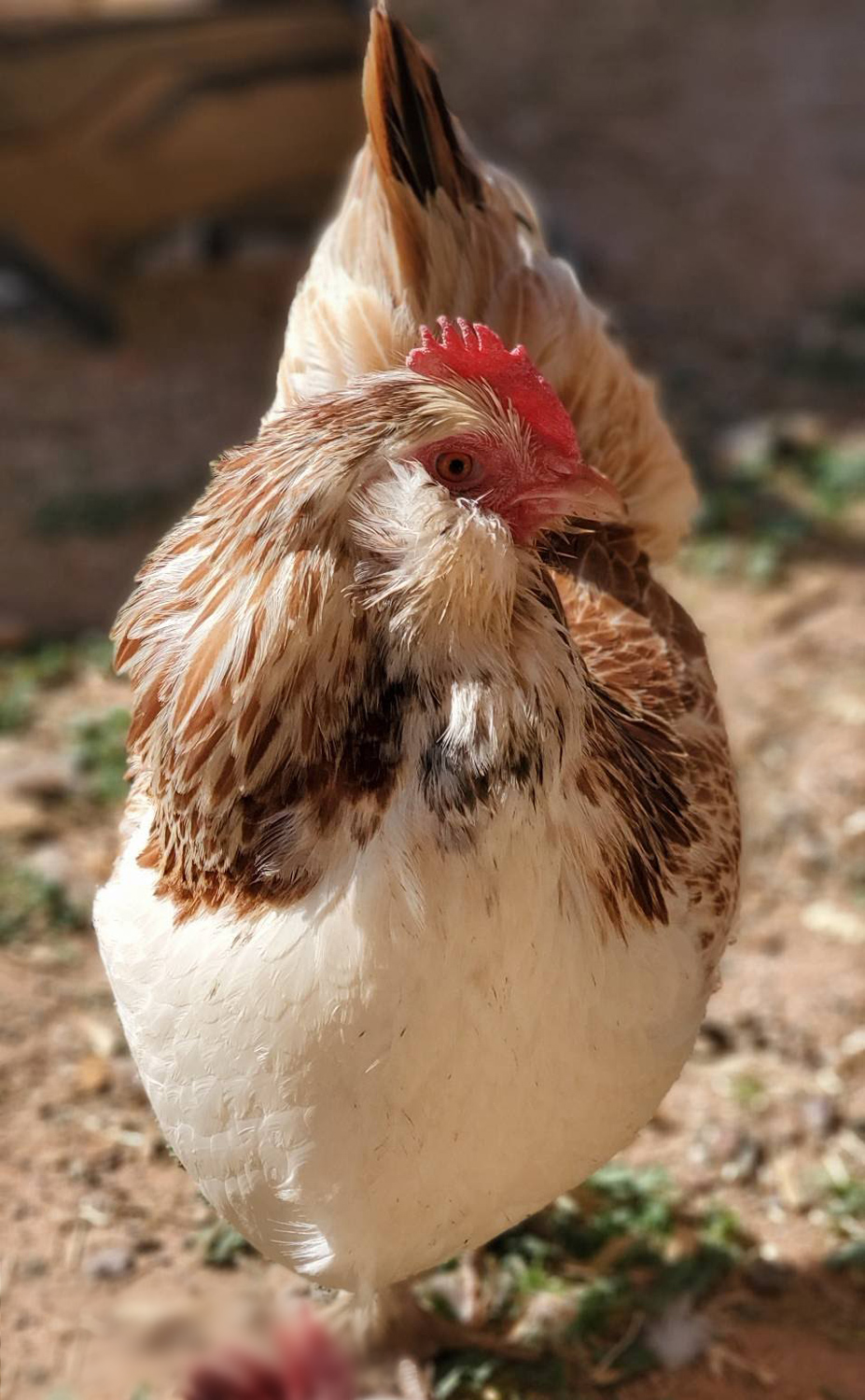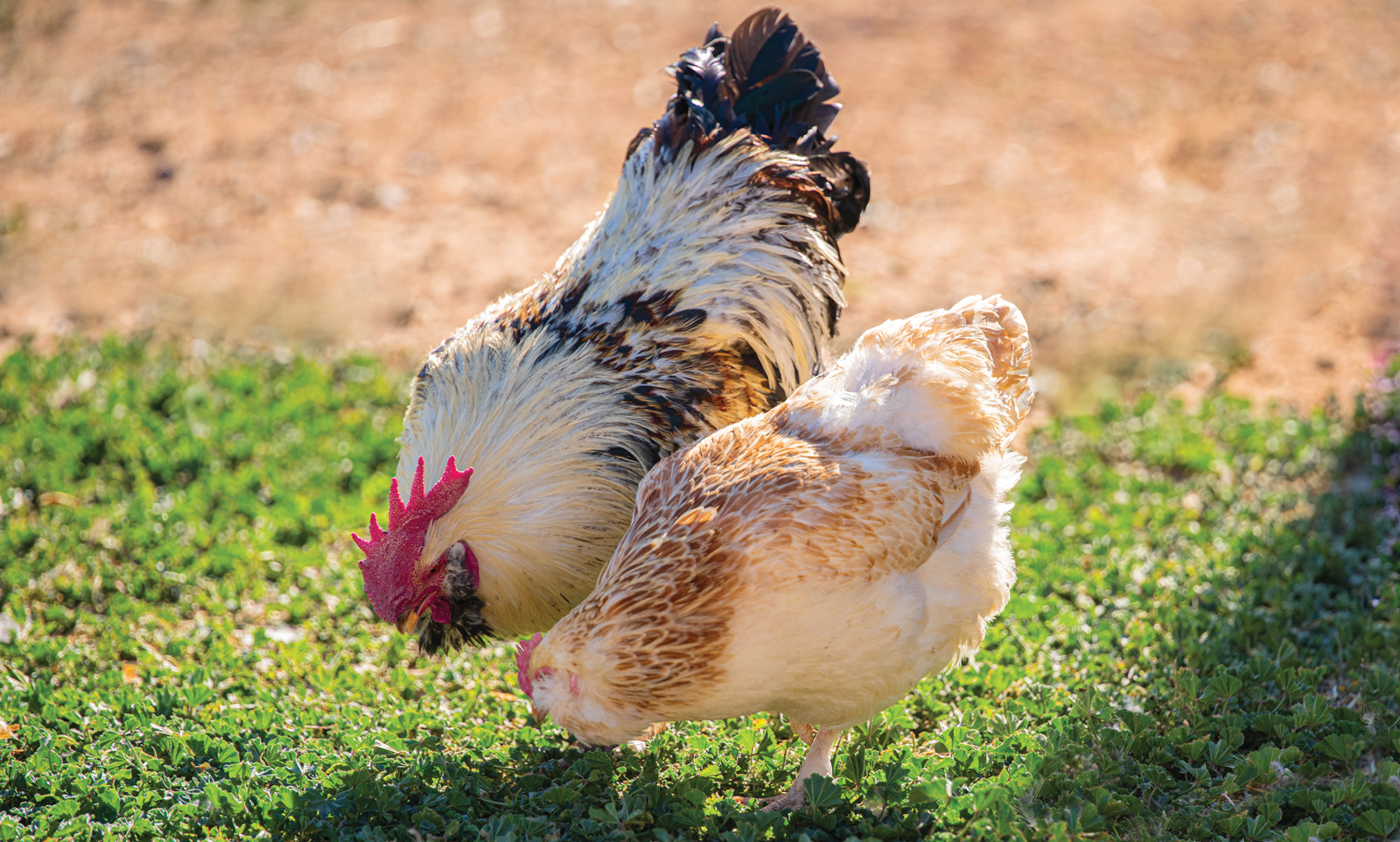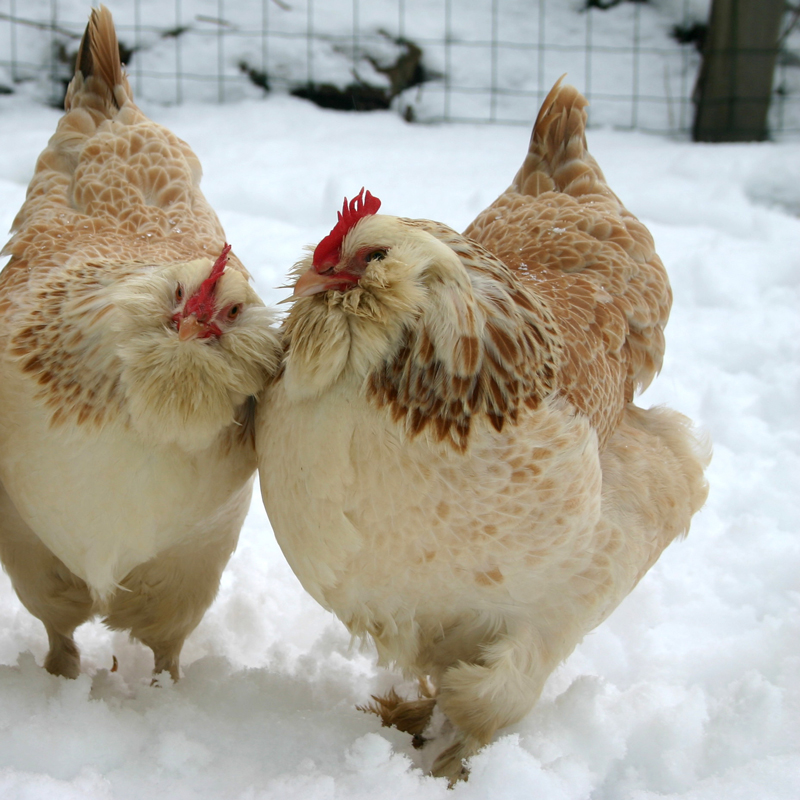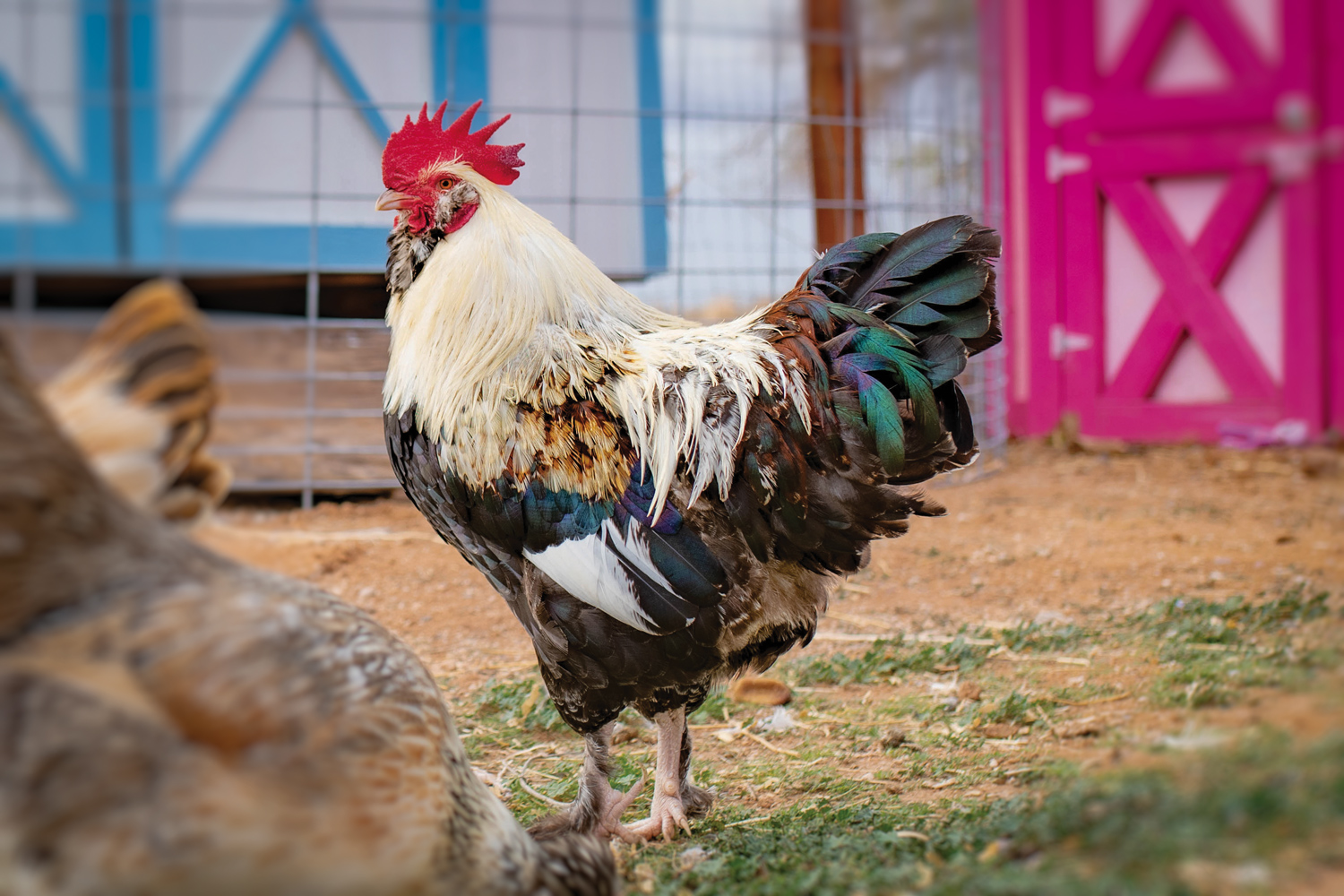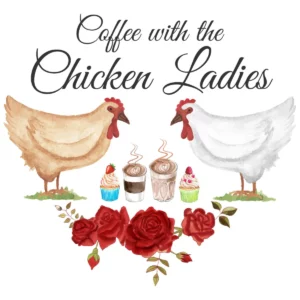This month’s breed is a chicken lady’s (or gent’s) dream come true! They’re ridiculously adorable, friendly and chatty, gentle with other breeds, super cold hardy, and an all around excellent companion. They make great show birds, and they’re pretty decent layers, too. If we tell you that they’re feather-legged as well as muffed and bearded, can you guess the breed? We’re talking about the amazing Salmon Faverolles.
At one point in time, roughly 15 or so years ago, the Faverolles were critically endangered. Fortunately, they’ve been rediscovered by a new generation of chicken keepers. The Livestock Conservancy’s 2021-2022 Poultry Census results have moved the Faverolles into the “Recovering” category of the Conservation Priority List.
Salmon Faverolles Heritage Chickens | Basic Breed Information
Faverolles were developed in France near the villages of Faverolles and Houdan, an area south of Paris. They were intended to be a true dual-purpose breed. Farmers were trying to create an excellent table bird with hens that were also good winter layers so that they had more products to offer for sale at the Paris winter market. The British Faverolles Society notes that many of the French farmers were trying to develop a breed that was not only dual purpose, but also one that tolerated confinement or caging well.
Faverolles are a fairly heavily-feathered medium-bodied chicken with feathered legs, a full muff and beard, a small straight comb, white legs, and five toes. In the Salmon Faverolles, hens are a beautiful mix of salmon, brown, and cream shades. Roosters have a black beard, and their chest is black as well. They look very different from the hens but are just as beautiful and friendly. The American Poultry Association Standard of Perfection puts their ideal weights at 8lbs. for roosters and 5.5lbs. for hens.
Salmon Faverolles Heritage Chickens | Coloration and Foundation Breeds
The Salmon color is unique among chicken breeds, but is not the only color variety of this breed. Though the APA only recognizes White (1981) and Salmon Faverolles (1914), Black, Blue, Buff, Cuckoo, White, and Ermine colorations all exist. The Ermine is very similar to the Columbian Wyandotte and Light Brahma. All of these color varieties are currently accepted by the British Poultry Society.
French farmers and breeders spent most of the second half of the 19th Century working on the Faverolles. Among the foundation breeds were Houdans, Brahmas, and Dorkings. The Livestock Conservancy notes that French Rennes, Flemish Cuckoos, and Malines may also have been included. The Faverolles’ fifth toe was almost certainly a gift from the Dorkings. The Houdan supplied the beard and muff, and Brahmas passed along their feathered legs and feet. In Salmon Faverolles, the males’ Duckwing color
pattern is another gift from the Dorking. As we mentioned earlier, the hens’ salmon color is unique and only occurs in this breed.
Salmon Faverolles Heritage Chickens | History
In the 1890s, Faverolles arrived in the UK and quickly became a favorite breed. According to poultry historian and author Lewis Wright, many chicken fanciers of the time considered the Faverolles the best breed to come out of France. Faverolles arrived in the US in the very early 1900s, imported by Dr. Phelps of New York. Dr. Phelps placed an ad in the 1904 Poultry Journal advertising his Faverolles, which had been imported directly from France and England. His published ads included Salmon, Ermine, Black, Red, Spangled, and Blue Faverolles.
Salmon Faverolles Heritage Chickens | Laying Statistics
Faverolles hens are actually pretty good layers, supplying around 180-200 large eggs per year. That works out to about 3-4 eggs per week. Most of the French breeds lay white eggs, but Faverolles produce light brown to cream shades with an occasional pink-tinted bloom showing up. Hens will occasionally go broody. Reports say they’re relatively easy to break from broodiness, however.
Salmon Faverolles Heritage Chickens | Ideal Living Conditions
These birds are personality plus. They’re sweet and docile, but quite active and alert at the same time. Salmon Faverolles often have lots to say! Be careful about putting them into an already established flock with strong personalities. They can end up on the bottom of the pecking order and may be bullied. With their small combs and wattles, and profuse feathering, Faverolles are fairly cold hardy. However, they don’t like the heat. They’ll need plenty of shade, cool water, and even fans in very warm and humid climates. You wouldn’t want to put them into a flock where they’re being chased or picked on in hot weather.
These feathery beauties make fantastic pets, and they’re great for families. They’ll lay a good number of eggs, and they do like to help with the garden and the compost. They are also very good show chickens and have been since the late 1800s. Faverolles are essentially fancy chickens with some practical skills. They are one of our favorite breeds, and we highly recommend them to anyone who enjoys an adorable, talkative bird with a fantastic personality. And all of those fancy feathers are a huge bonus, too!
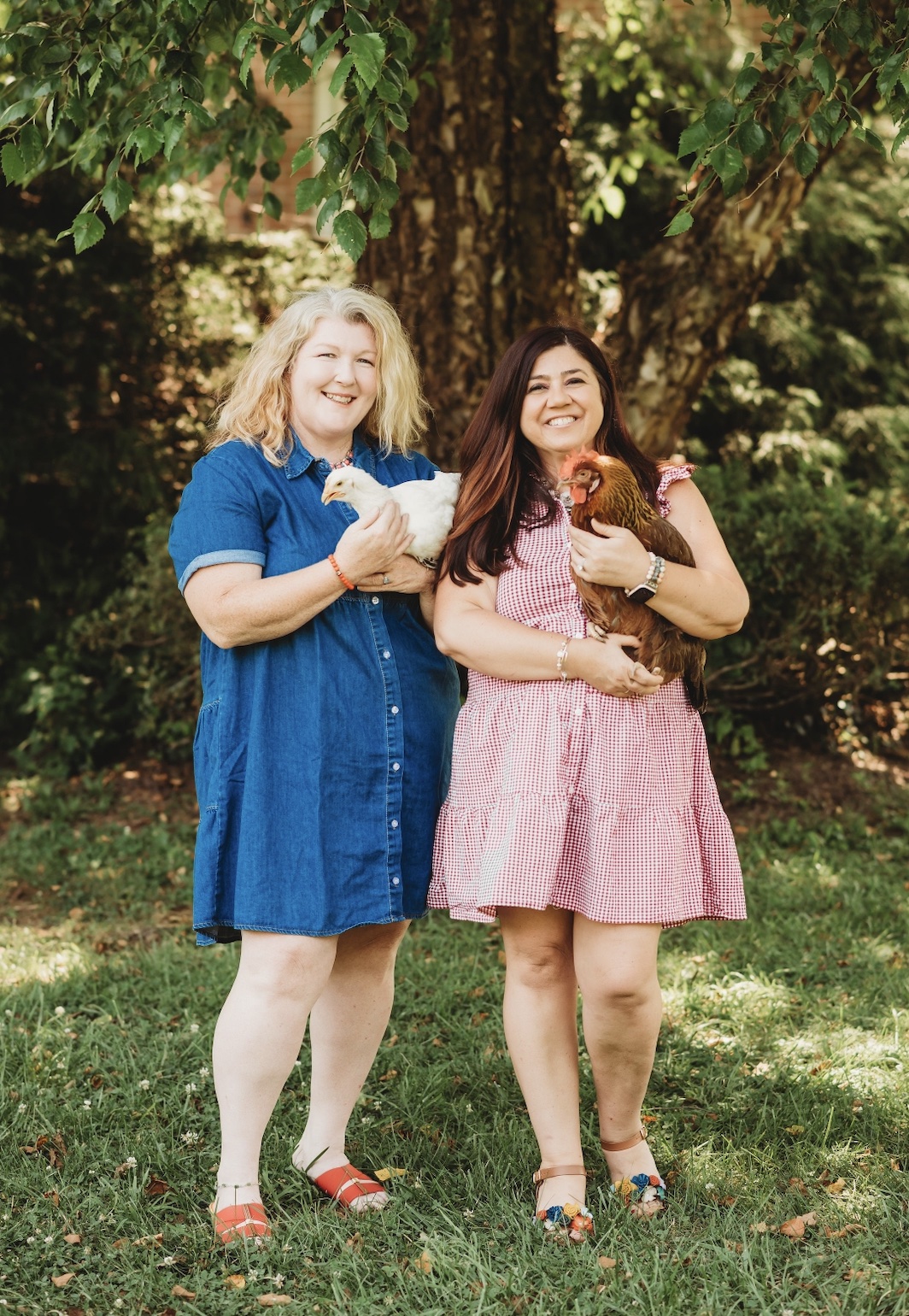
Holly Callahan-Kasmala grew up as a 4-H kid on a small horse farm. She has been keeping chickens for more than 20 years, and is passionate about Heritage chickens and helping people find the right breed for their needs. Holly has an MA in History, and is a long-time fiber artist/teacher. In addition to keeping Heritage breed chickens and rare breed sheep, she also grows heirloom cotton, dye plants, and all kinds of heirloom vegetables, fruit, and flowers on her small Maryland farm. She is the creator and co-host of Coffee with the Chicken Ladies Podcast.
Chrisie DiCarlo is a retired veterinary technician with a passion for helping people care for their poultry. During her 15 years in the field, she managed a technical trauma nursing care team in a busy urban veterinary hospital ER. She gave up her career to be a stay-at-home mom to her two amazing daughters. Chrisie has been keeping chickens for more than 7 years. She also loves growing herbs, fruit, and flowers on her small Maryland farm. She is the creator and co-host of Coffee with the Chicken Ladies Podcast.
Catch up on episodes of Coffee with the Chicken Ladies Podcast, stay up to date on their website, and follow along on social media.
Featured photos by Tawnie Freeland, and McMurray Hatchery staff.
Coffee with the Chicken Ladies Podcast
Coffee with the Chicken Ladies is a weekly podcast hosted by Chrisie DiCarlo and Holly Callahan-Kasmala. The podcast covers all things Pet Chicken! Each episode includes a breed spotlight, a relevant chicken keeping topic, a recipe using fresh eggs, and some retail therapy! The Chicken Ladies also feature interviews with expert guests who span the chicken keeping world. You’ll find the latest podcast episodes on their website, as well as other podcasting platforms.
You can learn more about Heritage Salmon Faverolles chickens by listening to Episode 13 and Episode 107 of the podcast.

